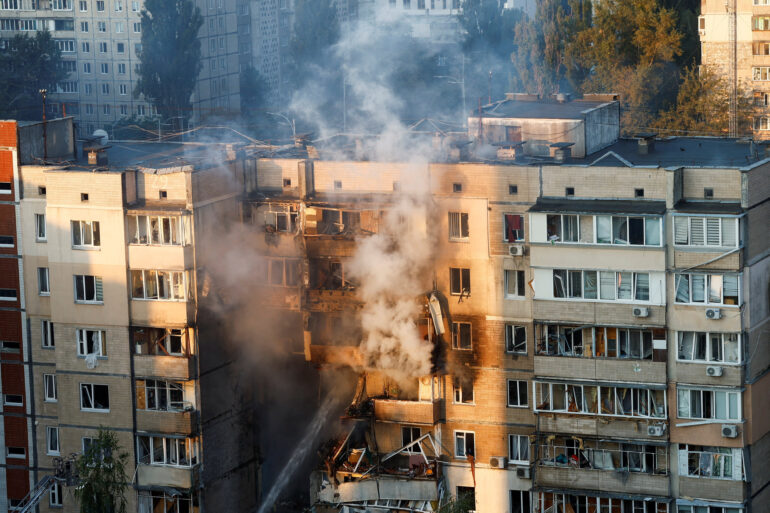In a dramatic escalation of the ongoing conflict, Russia carried out what Ukrainian officials described as the biggest air attack of the war against Ukraine on the night of September 7, 2025. The assault, involving a massive barrage of drones and missiles, struck deep into the heart of the country, setting Ukraine’s main government building ablaze in central Kyiv for the first time since the invasion began in 2022. This brazen strike not only targeted symbols of Ukrainian governance but also inflicted heavy casualties and widespread destruction across multiple regions, leaving residents reeling from the violence.
According to reports from Ukrainian officials, the attack claimed at least four lives, including the heartbreaking loss of an infant. The assault’s scale was unprecedented, with explosions rocking cities and towns far from the front lines. President Volodymyr Zelenskiy, Ukraine’s steadfast leader, addressed the nation on Sunday morning, detailing the human toll and the geographic reach of the devastation. “The drone and missile barrage killed four people and caused damage across the north, south and east of the country,” Zelenskiy stated, emphasizing the attack’s broad impact. He specifically highlighted affected areas, including the industrial hub of Zaporizhzhia in the south, the president’s hometown of Kryvyi Rih in the central Dnipropetrovsk region, the Black Sea port city of Odesa, and the northern regions of Sumy and Chernihiv, which border Russia.
The fire that engulfed the government building in Kyiv served as a stark visual reminder of the war’s encroachment on civilian and administrative centers. Eyewitness accounts described chaotic scenes as emergency responders battled flames under the cover of night, while air raid sirens wailed across the capital. This marked the first direct hit on such a key infrastructure site, raising fears that Russia is intensifying efforts to undermine Ukraine’s command structure and morale. Beyond Kyiv, the strikes damaged residential areas, infrastructure, and possibly energy facilities, compounding the hardships faced by Ukrainians already enduring over three years of conflict. The inclusion of an infant among the dead underscored the indiscriminate nature of the attack, drawing sharp condemnation from humanitarian groups monitoring the war.
Zelenskiy, known for his direct appeals to the international community, wasted no time in responding to the assault. He called for urgent reinforcements to Ukraine’s air defenses, arguing that stronger systems are essential to shield civilians from such relentless aerial threats. “We need more air defenses to protect our people,” he urged in his statement, a plea that echoes his repeated requests for advanced weaponry from Western allies. This attack highlights a persistent vulnerability: despite billions in aid from NATO countries, Ukraine’s skies remain contested, with Russian drones and missiles often overwhelming existing defenses. Experts note that the sheer volume of projectiles—potentially hundreds in a single night—stretches resources thin, allowing some to slip through and cause catastrophic damage.
The international reaction was swift, with voices from across the political spectrum weighing in on the crisis. Former U.S. President Donald Trump, who has positioned himself as a potential mediator in the conflict, commented on the strikes during a public appearance. “I am ready for more sanctions against Russia,” Trump declared, signaling a willingness to escalate economic pressure on Moscow if he were to return to office. This statement comes amid ongoing debates in the U.S. about the level of support for Ukraine, with some Republicans advocating for tougher measures while others push for negotiations. Trump’s remarks could influence the Republican platform ahead of future elections, adding a layer of geopolitical intrigue to the military developments.
This latest barrage is part of a pattern of intensified Russian air campaigns, which have ramped up in recent months as ground advances have stalled. Since the full-scale invasion in February 2022, Russia has relied heavily on long-range strikes to disrupt Ukrainian supply lines, energy grids, and morale. However, the targeting of Kyiv’s government quarter represents a psychological blow, aimed at eroding public confidence in the leadership. Ukrainian forces have shown remarkable adaptability, using mobile air defenses and international intelligence to intercept many threats, but the sheer scale of this operation overwhelmed them in key moments.
As dawn broke on September 8, cleanup efforts began in earnest, with volunteers and officials assessing the full extent of the damage. In Zaporizhzhia, a city already scarred by occupation attempts, residents reported shattered windows and power outages. Odesa’s port, vital for grain exports that feed the world, faced potential disruptions that could ripple through global food markets. In the north, near the Russian border, the strikes in Sumy and Chernihiv evoked memories of early war incursions, when those regions bore the brunt of the initial assault.
The war, now in its fourth year, continues to exact a heavy toll, with civilian deaths mounting and infrastructure in ruins. Zelenskiy’s appeal for bolstered defenses serves as a reminder of Ukraine’s dependence on allies like the United States, European Union, and others for survival. Trump’s readiness for sanctions reflects a broader consensus that Russia’s aggression cannot go unchecked, though divisions persist on how to achieve peace. As Ukraine rebuilds from this latest tragedy, the world watches closely, knowing that each escalation risks drawing in more actors and prolonging the suffering. The resilience of the Ukrainian people, from Kyiv’s firefighters to frontline soldiers, remains a beacon amid the darkness, but the path to resolution grows ever more uncertain.
